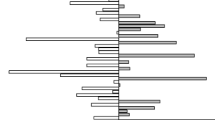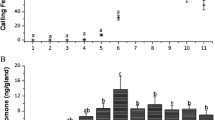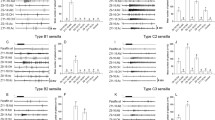Abstract
Influence of age, sex pheromone concentration and mating status on the response of Earias vittella and Earias insulana males to their female sex pheromone was studied using a T-shaped olfactometer. Males of both the species showed age related variation in their response to female sex pheromone and 4-day-old males were maximally responsive. Response of males of both the species to the female sex pheromone was concentration dependent and the level of response generally increased with an increase in pheromone concentration. In E. vittella, response of mated males was comparable with unmated males. In E. insulana, mating caused some reduction in the response of males.
Résumé
On a étudié l’influence de l’âge, de la concentration de phéromone sexuelle et le status de l’accouplement sur la réponse des mâles Earias vittella et Earias insulana à la phéromone sexuelle femelle conspécifique en se servant de l’olfactomètre d’une forme T. Les mâles do toutes les deux espèces ont montré une variation ayant rapport à l’âge dans leur réponse à la phéromone sexuelle femelle et les mâles âgés de 4 jours étaient les plus réponsifs. La réponse des mâles de toutes les deux espèces à la phéromone sexuelle femelle dépendait de la concentration et le niveau de la réponse augmentait généralement avec l’augmentation dans la concentration de phéromone. En E. vittella, la réponse des mâles accouplés était comparable avec les males non accouples. En E. insulana, l’accouplement a résulté en un peu de réduction dans la réponse des mâles.
Similar content being viewed by others
References
Baker T.C., Meyer W. and Roelofs W.L. (1981) Sex pheromone dosage and blend specificity of response by oriental fruit moth males. Ent. exp. appl. 30, 269–279.
Boeckh J. and Boeckh V. (1979) Threshold and odour specificity of pheromone sensitive neurons in the deutocerebrum of Antheraea pernyi and A. polyphemus (Saturniidae). J. Comp. Physiol. 132, 235–242.
Campion D.G. (1985) Survey of pheromone uses in pest control. In Techniques in Pheromone Research (Edited by Hummel H.E. and Miller T.A.), pp. 405–469. Springer-Verlag, New York, Berlin, Heidelberg, Tokyo.
Campion D.G., Hall D.R. and Prevett P.F. (1987) Use of pheromones in crop and stored products pest management: Control and monitoring. Insect Sci. Applic. 8, 737–741.
Castrovillo P.J. and Cardé R.T. (1979) Environmental regulation of female calling and male pheromone response periodicities in the codling moth (Laspeyresia pomonella). J. Insect Physiol. 25, 659–667.
Cork A., Chamberlain D.J., Beevor P.S., Hall D.R., Nesbitt B.F., Campion D.G. and Attique M.R. (1988) Components of female sex pheromone of spotted bollworm, Earias vittella F. (Lepidoptera: Noctuidae): Identification and field evaluation in Pakistan. J. Chem. Ecol. 14, 929–945.
El-Mosa H. (1986) Prospects of using sex pheromone for the control of spiny bollworm in cotton growing in Syria. Dirasat 13, 165–174.
Hagaman T.E. and Cardé R.T. (1984) Effect of pheromone concentration on organization of preflight behaviors of the male gypsy moth, Lymantria dispar (L.). J. Chem. Ecol. 10, 17–23.
Hall D.R., Beevor P.S., Lester R. and Nesbitt B.F. (1980) (E,E)-10,12-Hexadecadienal: A component of the female sex pheromone of the spiny bollworm, Earias insulana (Bois.) (Lepidoptera, Noctuidae). Experientia 36, 152–153.
Kawasaki K. (1985) Factors affecting orientation flight of Spodoptera litura to its sex pheromone in wind tunnel. Appl. entomol. Zool. 20, 352–353.
Kehat M., Gothilf S., Dunkelblum E. and Greenberg S. (1981) Captures of Earias insulana males in water traps and dry funnel traps baited with synthetic pheromone or virgin females. Phytoparasitica 9, 149–151.
Matsumoto S.G. and Hildebrand J.G (1981) Olfactory mechanisms in the moth Manduca sexta: Response characteristics and morphology of central neurons in the antennal lobes. Proc. R. Soc. London., B, 231, 249–277.
Seabrook W.D., Hirai K., Shorey H.H. and Gaston L.K. (1979) Maturation and senescence of an insect chemosensory response. J. Chem. Ecol. 5, 587–594.
Shorey H.H., Morin K.L. and Gaston L.K. (1968) Sex pheromone of noctuid moths XV Timing of development of pheromone responsiveness and other indicators of reproductive age in males of eight species. Ann. Entomol. Soc. Am. 61, 857–861.
Snir R., Dunkelblum E., Gothilf S. and Harpaz I. (1986) Sexual behaviour and pheromone titre in the tomato looper Plusia chalcites (Esp.) (Lepidoptera: Noctuidae). J. Insect Physiol. 32, 735–739.
Sternlicht M. (1986) Reassessment of pest control with pheromones in Israel and abroad (Inaugural talk prior to discussion). Phytoparasitica 14, 63–71.
Szocs G. and Toth M. (1979) Daily rhythm and age dependence of female calling behaviour and male responsiveness to sex pheromone in the gamma moth, Autographa gamma (L.) (Lepidoptera: Noctuidae). Acta Phytopath. Acad. Sci. Hungaricae 14, 453–459.
Tamhankar A.J. (1986) Studies on the reproductive behaviour of Earias vittella (Fabricius) and Earias insulana (Boisduval) and factors governing their reproductive isolation. PhD. Thesis, Mahatma Phule Agricultural University, Rahuri, Maharashtra, India.
Tamhankar A.J., Gothi K.K. and Rahalkar G.W. (1987) Influence of temperature induced larval diapause on pheromone-production by the female Khapra beetle, Trogoderma granarium Everts. Ind. J. Exp. Biol. 25, 276–277.
Thibout E. (1979) The sexual receptivity and competitiveness of mated males of Acrolepia assectella. Entomol. Exp. Appl. 25, 342–345.
Turgeon J.J., McNeil J.N. and Roelofs W.L. (1983) Responsiveness of Pseudaletia unipuncta males to the female sex pheromone. Physiol. Entomol. 8, 339–344.
Author information
Authors and Affiliations
Rights and permissions
About this article
Cite this article
Tamhankar, A.J., Gothi, K.K. & Rahalkar, G.W. Responsiveness of Earias Vittella and Earias Insulana Males to their Female Sex Pheromone. Int J Trop Insect Sci 10, 625–630 (1989). https://doi.org/10.1017/S1742758400021755
Received:
Revised:
Published:
Issue Date:
DOI: https://doi.org/10.1017/S1742758400021755




